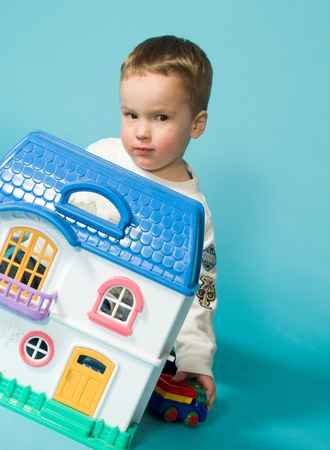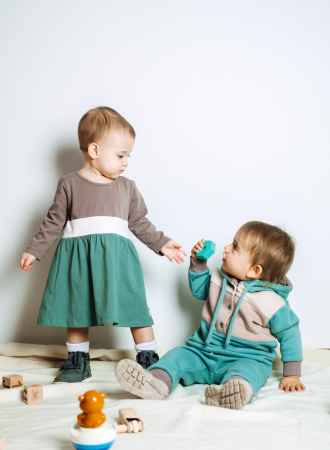Ever considered the implications of labeling toys as “for boys” or “for girls”? In our evolving understanding of child development and gender norms, there’s a growing recognition that pushing gender-specific toys can have unintended consequences.
Such categorizations, while seemingly harmless, can pigeonhole children into specific roles and expectations, limiting their holistic growth and understanding of the world around them.
As an expert in child development and play-based learning, I’ve developed a comprehensive guide that delves into the potential negative impacts of gender-specific toys on a child’s development.
Let’s navigate this nuanced topic together, understanding the deeper ramifications of limiting a child’s play based on societal gender norms and expectations.
Key Takeaways on the Effects of Strongly Gender Typed Toys on a Child Development
- Moderately gender-typed toys can be damaging to a child’s development by reinforcing stereotypes. As such, it is important to consider the implications of these gendered toys when choosing which ones are appropriate for children.
- Gender-neutral toys are essential for the early learning and development of kids. These toys promote inclusivity, empathy, and skills across different areas while breaking down harmful stereotypes.
- It is important to recognize the role that gender plays in child development and to promote gender equity and inclusivity. This can involve challenging stereotypes, providing equal opportunities and support for children regardless of gender, and creating environments that promote positive self-concept and identity development for all children.
Gender Stereotypes in Toys
Toys have a significant impact on how children perceive and internalize gender roles. Throughout history, many toys have been marketed specifically to boys or girls, often reinforcing traditional gender norms and stereotypes.
Gender-specific toys are those that are marketed and designed for either boys or girls. These toys often reinforce stereotypes, which can have a negative impact on children’s development.
| Aspect | Impact on Gender Roles | Description/Examples |
|---|---|---|
| Toy Marketing | Reinforcing Stereotypes | Toys are often marketed in gender-specific ways. For instance, action figures, trucks, and construction sets are frequently advertised for boys, while dolls, kitchen sets, and princess-themed toys are targeted towards girls. |
| Toy Colors | Color-Coded Gender Norms | The color palettes of toys often reflect gender stereotypes. Pink and purple are commonly associated with girls, while blue and green are linked to boys. This color-coding starts as early as infancy, with baby toys and accessories. |
| Role-Playing Toys | Occupations & Domestic Roles | Role-playing toys can subtly suggest gendered career aspirations or responsibilities. For instance, tool sets and doctor kits might be directed at boys, while cooking sets and baby dolls might be aimed at girls. |
| Toy Packaging & Imagery | Visual Reinforcement | Images on toy packaging can emphasize gender norms. Boys might be depicted playing aggressively or competitively, while girls might be shown in nurturing or passive roles. |
| Effects on Development | Limited Exploration | By guiding children towards gendered toys, they might miss out on a variety of skills and interests. For example, girls might not engage in building or spatial tasks as much, while boys might lack opportunities for empathetic or nurturing play. |
| Impacts on Career Choices | Long-Term Influences | Early exposure to gendered toys might influence future career choices, steering girls away from STEM fields or boys away from caregiving roles, for instance. |
| Social Interactions | Peer Pressure & Social Norms | Children learn from their peers. If they see certain toys being associated predominantly with one gender, they might feel pressure to conform, avoiding toys not deemed appropriate for their gender. |
The impact of gender-based toys
Gender-specific toys can limit the range of activities available to children, thus limiting their opportunities for learning and exploration. For example, girls may be encouraged to play with dolls while boys may be encouraged to play with cars or action figures.
This limits the types of experiences they have access to, as well as the skills they develop in playing with these toys. Gender-specific marketing messages by toy manufacturers can lead children to believe that certain activities are only appropriate for one gender or another.

How gender stereotypes are reinforced by toys
The colors used in packaging and advertising also contribute to reinforcing stereotypes through toy selection from toy aisles. For instance, feminine toys usually come in pink colors while boys toys (blue toys) are blue. This encourages boys and girls to select different types of toys based on color alone without considering other factors such as interest level or skill development potential.
When characters featured in television shows or movies promote certain behaviors related to traditional roles (such as cooking for women), it reinforces the idea that there is an accepted way of behaving based on one’s gender identity rather than individual preferences and interests.
When children feel limited by what society expects from them based on their gender identity instead of exploring new activities freely, it can lead them down a path where they become less confident in themselves due to feeling like they don’t fit into societal norms because their interests differ from what is expected from them according to their assigned sex at birth.
When kids do not explore all possible options available, it hinders creativity, problem solving abilities, motor skills, communication skills, socialization abilities and empathy levels.
All these aspects help shape who we become later in life so if any aspect gets neglected during childhood then our overall growth will suffer.
Examples of Gender Specific Toys
| For Boys | Description/Examples | For Girls | Description/Examples |
|---|---|---|---|
| Action Figures | Superheroes, soldiers, and characters from action-oriented media are often targeted towards boys. | Dolls | Dolls, especially those focused on beauty, fashion, or motherhood, like Barbie or baby dolls, are traditionally marketed to girls. |
| Construction Sets | Building sets, such as certain LEGO sets or erector sets, that emphasize construction, machinery, or combat. | Dollhouses | Miniature houses with furnishings and figures, emphasizing domestic play and interior decoration. |
| Cars & Trucks | Toy vehicles like monster trucks, race cars, and machinery. | Tea Sets | Miniature tea or cooking sets that emphasize social gatherings or domestic scenarios. |
| Weapons & Combat Toys | Toy guns, swords, and other combat-related toys. | Beauty & Dress-Up Kits | Makeup kits, jewelry sets, and costumes centered around beauty or princess themes. |
| Science & Adventure Kits | Kits that emphasize exploration, such as chemistry sets or detective kits. | Craft & Jewelry Kits | Sets that focus on creating jewelry, decorating, or other traditionally “feminine” crafts. |
| Sports Equipment | Footballs, baseball bats, or other sports equipment often associated with male-dominated sports. | Nurturing Toys | Toys like baby doll strollers, feeding sets, or anything emphasizing caregiving. |
Note: It’s essential to understand that these categorizations are based on traditional marketing practices and societal norms, which have often perpetuated gender stereotypes.
In recent years, there has been a significant push towards more gender-neutral toys and marketing practices, recognizing that all children can benefit from a diverse range of play experiences regardless of their gender. Still, the legacy of gendered toys remains influential in many parts of the world and the toy industry.
Alternatives to Gender-Specific Toys
If you’re looking for alternatives to boys toys or girls toys, here are some ideas:
Unisex toys
Unisex toys provide an opportunity for children to play with items that don’t reinforce traditional gender roles. By allowing kids to choose from a variety of unisex options, parents can give them the freedom to explore different interests without having their choices be dictated by society’s expectations.
Unisex toys often promote more open-ended play which encourages creative thinking and problem solving skills in young minds. Generic toys for both genders are important for parents if they have more than one child.

Open-ended toys
Open-ended toys are those that have no specific purpose or goal but instead encourage imaginative play. Examples include”
- wooden building blocks
- dolls with diverse clothing options, dress up clothes such as capes and hats
- arts & crafts supplies like paint sets
- building materials like cardboard boxes
- musical instruments like drums or tambourines
- outdoor equipment such as balls or jump ropes
- board games such as checkers or chess
- stuffed animals

Toys play a crucial role in a child’s development, and it’s worth exploring how they impact different aspects of a child’s growth. It’s fascinating to note that toys allow for endless possibilities when it comes to playing so a young child can use their imaginations freely while developing important fine motor skills, artistic skills, and cognitive skills along the way.
It is important for parents to consider providing diverse toy options from the toy aisle that represent people from various backgrounds and cultures in order to promote inclusion among all genders and ages. This could mean purchasing books featuring characters from different racial/ethnic groups or buying baby dolls with a doll house wearing traditional clothing from around the world for little kids.
Both activities will help expand your child’s understanding about diversity while encouraging them to embrace differences between individuals of the opposite sex rather than using stereotypes based on gender roles alone.
What Is the Importance of Gender-Neutral Toys in a Early Learning and Development of Kids?
Gender-neutral toys play an essential role in the early learning and development of kids. These toys are designed to be inclusive of all genders, encouraging children to explore their interests and express themselves freely without being restricted by traditional gender stereotypes.
One of the most significant benefits of gender-neutral toys is that they help break down gender barriers, which can limit a child’s creativity and potential. Boys, for instance, may feel discouraged from playing with dolls or cooking sets because these toys are often labeled as “girly” or associated with physical attractiveness and domestic skills.
Similarly, girls may feel pressured to avoid playing with cars or building sets because these are seen as “boyish.” These toys help remove these limitations, allowing children to explore a wide range of activities and develop skills across different areas.
These toys also promote spatial skills, empathy and social skills by encouraging children to interact with others and share their toys. These toys teach children to collaborate, communicate, and respect each other’s ideas and feelings. They also help to break down harmful gender stereotypes that can lead to bullying, teasing, and exclusion.
Moreover, gender-neutral toys can also help children develop important cognitive and physical skills. For example, building sets and puzzles can promote problem-solving and spatial awareness, while playing with dolls can help children develop nurturing and empathy skills. By offering a diverse range of toys that appeal to all genders, children can discover their passions and interests and develop a broad range of skills.

How Can Parents Reduce the Impacts of Gender Specific Toys on Childhood Development?
Gender-specific toys have been a pervasive aspect of children’s play for decades. While toys are intended to be a source of joy and entertainment, they can also shape children’s beliefs and behaviors about gender roles. However, there are strategies that parents and caregivers can employ to reduce the impact of gender-specific toys on children and promote more gender-neutral play. Here are some of these strategies and their potential benefits.
- Encourage a variety of children’s toys. Provide your child with a wide variety of toy choices that are not just marketed towards their gender. This can include toys that are typically marketed towards the opposite gender, as well as gender-neutral toys. This allows your child to explore their interests without feeling limited by societal expectations.
- Talk to your child. Have open and honest conversations with your child about the harmful effects of gender stereotypes and the importance of being true to oneself. Encourage your child to think critically about the messages they receive from the media and society.
- Don’t limit your child’s choices. Allow your child to choose the toys they want to play with, regardless of their gender. Avoid making comments that may suggest that certain toys or activities are only for a specific gender.
- Be a role model. Model positive behavior by participating in activities that challenge gender stereotypes. For example, if you’re a father, consider cooking or doing household chores with your child to break down traditional gender roles.
- Look for inclusive brands. When purchasing toys, look for brands that are inclusive and promote gender equality. Many toy companies now offer gender-neutral or inclusive toy lines that cater to all children.
- Discuss with friends and family. Discuss the impacts of gender stereotypes and gender-specific toys with friends and family members. Encourage them to also provide a variety of toys and to avoid limiting a child’s choices based on gender.
By providing your child with a wide range of toys and encouraging them to challenge gender stereotypes, you can help promote healthy development, remove social costs, abolish gender inequality and a positive self-image. Remember, your child should be able to explore their interests without feeling limited by societal expectations.
Research on the Effects of Gender-Specific Toys on Developmental Outcomes
Research has shown that gender-specific toys can have both positive and negative impacts on a child’s growth and development. Research shows that when children are exposed to gender-stereotyped toys, they tend to develop more rigid ideas about what is appropriate for boys and girls. This can lead to the reinforcement of traditional gender roles in society.
On the other hand, research also suggests that playing with certain types of gender-specific toys may help children develop skills related to their interests or abilities. For example, studies have found that girls who play with dolls may have a better thought process to recognize facial expressions and emotions than those who do not play with dolls. Similarly, boys who play with construction sets may show improved new skills and spatial reasoning compared to those who don’t use these types of toys.
Exposing children to diverse toy options—including both unisex and gender-specific items—can foster creativity in young minds by encouraging them to explore different activities and interests without being limited by societal expectations or stereotypes about what is “appropriate” for each sex.
Finally, some studies suggest that playing with different toys can help build problem solving skills while promoting critical thinking in children from an early age.
These findings indicate that providing young people access to a variety of stimulating activities involving a combination of pink and blue toys, regardless of whether they are traditionally considered “masculine” or “feminine”, may be beneficial for large motor development, cognitive sequencing and overall optimal development of skill sets during childhood and beyond.

FAQs on How Gender Specific Toys Can Negatively Impact a Child’s Development
How do toys contribute to a child’s understanding of gender?
Toys play an important role in helping children understand gender and gender roles. Toys can help to reinforce traditional stereotypes, such as dolls and other girls toys for girls and action figures and other masculine toys for boys, or they can be used to challenge these norms.
For example, toys that feature female characters in traditionally male-dominated fields like science or engineering may encourage young girls to pursue those same interests. On the other hand, toys that feature both genders playing together without any predetermined roles could promote a more equitable view of gender roles.
Ultimately, it is up to parents and caregivers to choose toys carefully so that children are exposed to positive messages about gender equality.
Does gender have an effect on child development?
Yes, gender does have an effect on child development. Gender refers to the social and cultural expectations associated with being male or female, rather than biological sex. These expectations can influence the way that children are treated, the opportunities available to them, and the messages they receive about what it means to be a boy or a girl.
One way that gender can affect child development is through gender roles and stereotypes. Children are often socialized to adopt gender-specific behaviors and interests, such as boys playing with trucks and girls playing with dolls. These gender expectations can influence children’s cognitive, emotional, and social development.
For example, boys are often encouraged to be assertive and competitive, while girls are encouraged to be nurturing and cooperative. This can lead to differences in communication styles, problem-solving strategies, and emotional expression. Boys may be more likely to take risks and engage in physical activities, while girls may be more likely to focus on social relationships and express their emotions more openly.
Gender can also affect children’s self-concept and identity development. Children may internalize gender stereotypes and beliefs about what it means to be a boy or a girl, which can influence their self-esteem and sense of identity. For example, boys who do not conform to traditional gender norms may experience social rejection and stigma, which can lead to feelings of shame and low self-worth.
How do toys affect a child’s development?
Many toys play an important role in a child’s development. They can help children learn problem-solving skills, develop motor skills, and foster creativity. Toys also provide opportunities for social interaction with peers and adults.
Through play, children learn about the world around them and practice communication skills such as sharing and taking turns. Toys are a great way to encourage exploration of different concepts like numbers or colors.
Ultimately, toys can be powerful tools for learning that support physical, cognitive, emotional and social growth in young children.

Why are gender roles harmful to children?
Gender roles can be harmful to children in many ways. By placing expectations on a child based solely on their gender, it limits their potential and restricts them from exploring activities they may be interested in. This can lead to feelings of inadequacy, low self-esteem, and depression.
It also reinforces negative stereotypes about boys and girls which can have long-term effects on how they view themselves as well as others. For instance, violence and aggression are often emphasized on boys toys.
Gender roles are often rooted in outdated ideas about what is “normal” for each gender, so it is important for parents to allow their children to explore different activities without judgment or expectation based on gender.





